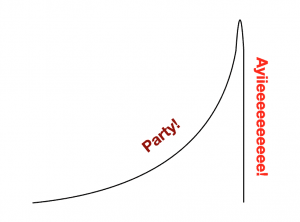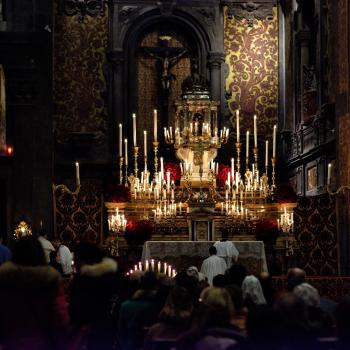 A shouting match is often perversely compelling in the same way that a road accident is: it’s ugly, but it commands your attention. Very occasionally, however, a viciously heated conversation manages to achieve aching tedium at the same time. For an example of this paradox, ask some religious studies scholars what religion is. The ensuing debate will be a painstaking, often bitter exchange of views that ultimately boils down to the deflationary proposition that there is, in fact, no such thing as religion at all. But my mentor and collaborator Rich Sosis and I have a different perspective. While there’s no one-size-fits-all definition of religion, we think that looking at religions as a complex adaptive systems helps make sense of both their persistent cross-cultural similarities and their widely varying differences. Recently, we published a chapter on a computer model exploring this vision in an edited volume, Human Simulation.
A shouting match is often perversely compelling in the same way that a road accident is: it’s ugly, but it commands your attention. Very occasionally, however, a viciously heated conversation manages to achieve aching tedium at the same time. For an example of this paradox, ask some religious studies scholars what religion is. The ensuing debate will be a painstaking, often bitter exchange of views that ultimately boils down to the deflationary proposition that there is, in fact, no such thing as religion at all. But my mentor and collaborator Rich Sosis and I have a different perspective. While there’s no one-size-fits-all definition of religion, we think that looking at religions as a complex adaptive systems helps make sense of both their persistent cross-cultural similarities and their widely varying differences. Recently, we published a chapter on a computer model exploring this vision in an edited volume, Human Simulation.
True to their name, complex adaptive systems are both complex and, well, adaptive. Complexity means that a system is more than the sum of its parts, with a hierarchical structure organizing the different levels that make up the whole. Think of a storm system. Rather than just a bunch of water molecules clumped together, a storm is made of water molecules, air currents, and energy transformations formed intricately into a massive structure. From local temperature variations to drops in pressure, there are just too many complex interactions between too many parts for the whole thing to be comprehensively predictable.
Adaptivity, on the other hand, means that the system is “goal-seeking,” constantly readjusting the relationships between its parts and structure in order to maintain its own integrity and overall form. A complex adaptive system works to maintain dynamic equilibrium in the face of perturbations and disturbances in the environment — in other words, its ultimate goal is simply to continue to exist. While weather systems aren’t adaptive in this sense, organisms and ecosystems are. They respond to disturbances by seemingly attempting to “right” themselves, seeking out the right conditions that will allow them to continue functioning.
Religious Systems
Wait, isn’t religion all about beliefs in God (or gods)? What do complex systems and dynamic equilibrium have to do with that? We argue that religious beliefs are only one component of what we colloquially call religions, positing that other components include ritual, authority structures, and obligations, as well as myths, norms, and taboos. Together, these eight components interact with one another in super-complicated ways that can vary dramatically across times and places. The role of authority in Quakerism is very different from its role in Catholicism. The myths of Judaism are different from those of Hinduism. Yet we explicitly argue that “religious systems” are a real category (not just a social construct), and they always include these components in some configuration.
Of the eight components of religious systems, ritual is by far the most important, because it’s the way people indicate their acceptance of the authority and norms that define the religious community. As anthropologist Roy Rappaport pointed out, participating in ritual doesn’t necessarily mean that someone inwardly believes a religion’s propositional claims. A Jewish congregant may not really believe that God rescued the Israelites from Egypt, but if she attends a seder, she clearly feels that she ought to take part that particular Jewish ritual observance. At some level, she “accepts” the obligatory nature of the ritual requirement.
Ritual practice in this sense can actually lead to belief. If you find yourself doing a lot of Jewish things — attending seders, davening, celebrating Yom Kippur this week — you may eventually conclude that Judaism’s claims must have some legitimacy. Otherwise, why are you doing all this stuff? As Rich has written elsewhere,
cognitive dissonance…will cause nonbelievers to either modify their belief or discontinue the ritual.
Legitimacy is the key here. People willingly obey the laws of governments they see as legitimate. But when the government loses popular legitimacy, people don’t feel so inwardly compelled to behave lawfully. The government has to resort to raw force. In the same way, people willingly perform the rituals of their religion when they see the authoritative force of the religious community as legitimate. But when it begins to lose legitimacy, a drop-off in ritual performance is sure to follow.
Of course, this isn’t an all-or-nothing question. Some Catholics attend Mass semi-regularly but never go to confession. In general, though, the more someone sees legitimacy in Catholic authority, the more wholeheartedly he’ll invest himself in that tradition. And by the same token, the more Catholic rituals he regularly partakes in, the more inwardly convinced he’ll probably feel about Catholic doctrines.
This ratcheting dynamic — ritual practice leading to more belief, which in turn leads to more ritual — is an example of a positive (or reinforcing) feedback loop, another key feature of complex adaptive systems. Negative feedback keeps core parameters in line by correcting against changes in the system. The classic example is a thermostat, which keeps the room within a desired temperature range by switching on the heater when the room gets cold or, when it get hot, activating the the air conditioning. While complex adaptive systems make plentiful use of this kind of negative feedback, they also use positive or reinforcing feedback to drive adaptive behavior. Remember: a complex adaptive system’s goal isn’t to stay the same. It’s just to persist, which sometimes entails making large-scale changes in the way the system operates. Positive feedback can enable these big changes, pushing the system to new regimes of behavior.
The Computer Model
Over the course of a couple of years, Rich and I sat down in collaboration spaces in Boston and Virginia and implemented these ideas in a computer simulation, complete with all eight of the components we identified. Because most religious systems throughout history have been more or less integrated with their economic and social systems, we structured the simulation as an ecological model. Like any organism, the social system exists within an environment from which it strives to extract energy (think farming or coal mining). But unlike other organisms, the religious system must make a “choice” about how much of that extracted energy to expend on ritual versus other vital activities, such as reproduction and further energy-seeking.
When the system invests energy on ritual, positive feedback kicks into play. The more its members participate in ritual, the more legitimacy the religious system enjoys, and the stronger its authority — which in turn motivates people to partake in more ritual. At the same time, ritual motivates participants to cooperate more closely, which increases the efficiency of their energy harvests. Think about Rousseau’s classic stag hunt dilemma: if everyone just hunts alone, the best they can bring back is gamey little rabbits. But if they all go hunting together in cooperation, they can corner and catch a stag, and have much better-quality meat for more people. In our simulation, participating together in ritual makes people more likely to cooperate and coordinate for a generic stag hunt. Voilà: the energy harvest grows.
But there are additional factors at play. If people’s overall health isn’t good, that harms legitimacy. Legitimacy also takes a hit if more people are dying than are being born. These effects reflect the behavioral ecological expectation that people’s feelings about their religious group are a kind of shorthand assessment of the likely biological payoff of staying in that group.
What does this mean? Imagine being a young, single person walking into a new church. If you see a lot of gray heads and empty pews, you think, “Meh, I’ll go somewhere else next week.” Conversely, do you see a building full of healthy-looking couples, kids running around, and attractive other singles? Then you feel an urge to stick around. This cool assessment of the prospects for religious groups might sound mercenary. But our approach simply captures the fact that, whatever else they are, religious communities are also relationships that people enter into for the sake of fulfilling practical life goals. From a behavioral ecological standpoint, the two most important goals are survival and reproduction. A social or religious system that doesn’t help its people thrive in these two areas will tend to lose members — either because more members are dying than are being born, or because outsiders don’t find it attractive, leading to few conversions and many deconversions. Our model includes both these pathways.
Charisma
One final feature of the model was its ability to shift from a “normal” form of religious authority to charismatic authority. This concept hearkens back to German sociologist Max Weber, who posited that certain kinds of religious leaders gained prominence thanks to their powerful personalities and exceptional displays of faith in (sometimes novel) religious doctrines. Weber noted that charismatic authority is usually temporary: after charismatic founders die, religious sects tend to shift to a more staid, “routinized” form of authority, complete with regular rituals and a hierarchy of ministerial offices.
But routinization isn’t necessarily one-way. When times of crisis hit an established religious community, charismatic forms of worship often erupt. These resurgent epochs of charisma can pave the way for long-term social change as old leadership hierarchies crumble, or they might simply release enough flexibility into the society for it muddle through periods of instability.
A classic real-world example of charismatic authority is the unprecedented explosion of Pentecostal Christianity over the last century. Starting during the first Gilded Age, some Christians began worshipping in ecstatic, often individualistic ways, overturning older traditions in favor of a direct, personal experience of God. Today, Pentecostalism is one of the fastest-growing religious movements in the world. While Pentecostal services don’t look much like traditional Catholic Mass, you could make the argument that Christian communities have used Pentecostalism to adapt to the never-ending change and dislocation of the globalized era, while trying to retain core Christian commitments.
In our model, Rich and I programmed in a threshold for “legitimacy crisis,” when the religious system completely lacks legitimacy in the eyes of its members. A simulation parameter determines whether the community shifts to a charismatic form of authority in response, and if so, how dramatic the shift is. If the charismatic authority function gets activated, then the authority of the religious system collapses — crucially, even as belief in supernatural beings skyrockets.
In some cases, the resurgence of belief in the supernatural can jump-start a renewed participation in ritual, and so slowly rejuvenate cooperation, biological thriving, and, eventually, legitimacy. When resurgent legitimacy passes the threshold on the way up, then the charismatic authority goes dormant again. (An example of negative, or corrective, feedback.) The religious system has managed to hold together.
Running the Model
We ran simulations to test how charisma would affect artificial societies’ ability to adapt to challenges. Simulation runs stopped if the population of the simulated religious system dropped below 2, or if it ran out of energy. After programming in the target goal of 250 time steps (roughly the equivalent of 20 simulated years in this model), we asked the simulation engine to identify combinations of parameters that would maximize population at the end of this time period. Then we entered those same parameter values into new simulations again, but this time let the simulation play out indefinitely.
Depending on your sense of humor, what we found was grimly humorous or existentially horrifying: all but one of the simulations collapsed precipitously shortly after the 250th time step. The cause of the collapse was resource overshoot. Asked to identify parameter combinations that maximized population at the 250th time step, the simulation engine (being just a machine, after all) came up with settings that generated exponential population increase slightly before that point. This suddenly mushrooming population satisfied our test conditions, but then outstripped the environment’s resource base. The population charts for these religious systems looked like this:
So could a little charisma change these societies’ doomed trajectory? We identified 14 parameter combinations that caused the religious systems to spike and crash around the 250th time step. Then we entered those same parameters into new simulations, but with a single alteration: we maximized the value of the charisma parameter.
Of these 14 simulated societies, 12 lasted longer — sometimes much longer — with the charisma parameters dialed up to max. One explanation could be that heightened charisma enabled societies to flexibly adjust and adapt to challenges, leading to a longer societal lifespan. However, each of these societies eventually did crash, and often the crash was even more dramatic when did come.
In another experiment, we asked the simulation engine to minimize the population of the artificial societies without pushing the population below the threshold of collapse. It only identified two parameter combinations, but, interestingly, both combinations were indefinitely stable — they never collapsed — and had very high charisma parameter values.
The Takeaway
First, don’t overshoot your resource base. Looking qualitatively at the dynamics that drove the extreme population spikes and crashes, we discovered that there were long regimes during which the population grew only slowly, which — in this simulation — allowed organic resources to build up in the environment without being over-exploited. The slow population growth led to low average levels of legitimacy, which meant little ritual and cooperation and, hence, few resources extracted from the environment. For long periods, things stayed in this boring but stable status quo.
Then, slowly, imperceptibly, the amount of resources in the environment reached a tipping point, and the human population began to increase. As the society grew, it needed more energy — but it also had more people to extract energy from the environment. At the same time, the perceived legitimacy of the social system rebounded as people saw their community growing. More ritual meant more cooperation, and more cooperation meant more efficient extraction of energy. The system’s new regime was dominated by ever-reinforcing feedback between population, legitimacy, ritual, cooperation, and resource extraction.
For a long time, the stored-up resources seemed endlessly abundant, sufficient to fuel a seemingly limitless population increase. But at a critical point — shortly after the 250th time step in the first simulations — the number of people demanding energy from the environment surpassed the amount of remaining resources. Because growth was exponential, the system didn’t have time to adapt. One year, there was enough food. The next year the society was an archeological site. Increased societal flexibility could delay this outcome, but not avert it.
This doomsday scenario was, I have to admit, unnerving to watch — particularly when you compare the profile of the simulated population spikes to the actual charts of human population growth over the past few thousand years.
Of course, it was just a simulation. One lesson computer modeling teaches is that it’s actually very hard to achieve dynamic equilibrium in complex systems. With their innumerable combinations of negative and positive feedback loops and elements, most simulations run straight to the extremes or crash out. In the real world, the dynamics of ecosystems, organisms, and religious communities tend to be much more resilient. To achieve this kind of natural resilience in silico, we’d need to embed religious communities in more realistic ecological settings, including multiple societies to cooperating and competing.
The point remains that religions aren’t just sets of maxims or beliefs about invisible beings. They are are complex systems comprising people, social relationships, behaviors, and beliefs. Our pivotal claim is that, like other complex adaptive systems, religious communities exhibit characteristic adaptive behavior that advances their own perpetuation. While different religions configure themselves in very different ways, the nexus of ritual, authority, belief, and cooperation is universal. Everywhere, we find rituals and social organization entwined with norms and beliefs, flexing against the strains of the world, forming a social whole that, if you didn’t know better, you’d say was trying to survive. Even when the world has different plans.













